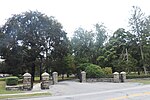Yonkers () is a city in Westchester County, New York, United States. Developed along the Hudson River, it is the third most populous city in the state of New York, after New York City and Buffalo. The population of Yonkers was 211,569 as enumerated in the 2020 United States Census. It is classified as an inner suburb of New York City, located directly to the north of the Bronx and approximately two miles (3 km) north of Marble Hill, Manhattan, the northernmost point in Manhattan.
Yonkers's downtown is centered on a plaza known as Getty Square, where the municipal government is located. The downtown area also houses significant local businesses and nonprofit organizations. It serves as a major retail hub for Yonkers and the northwest Bronx.
The city is home to several attractions, including access to the Hudson River, Tibbetts Brook Park, with its public pool with slides and lazy river and two-mile walking loop Untermyer Park; Hudson River Museum; Saw Mill River daylighting, wherein a parking lot was removed to uncover the Nepperkamack (Saw Mill River); Science Barge; and Sherwood House. Yonkers Raceway, a harness racing track, renovated its grounds and clubhouse, and added legalized video slot machine gambling in 2006 to become a "racino" named Empire City. In more recent years, Yonkers has undergone progressive gentrification.Major shopping areas are located in Getty Square, on South Broadway, at the Cross County Shopping Center and Westchester's Ridge Hill, and along Central Park Avenue, informally called "Central Ave" by area residents, a name it takes officially a few miles north in White Plains. Yonkers is known as the "City of Seven Hills", including Park, Nodine, Ridge, Cross, Locust, Glen, and Church Hills.






